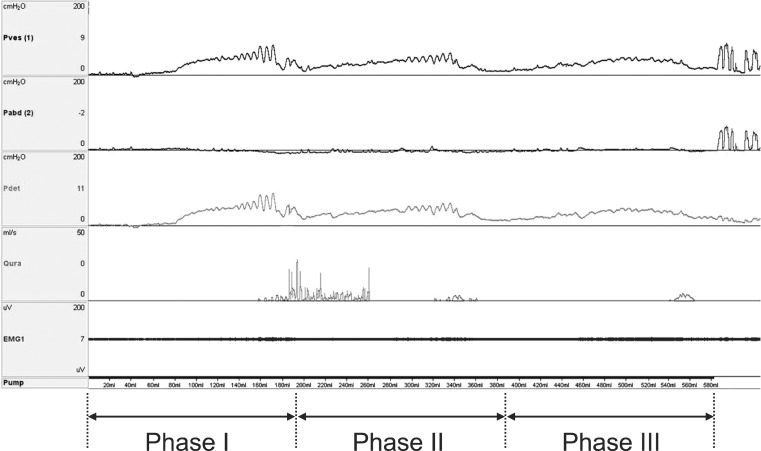Ann Rehabil Med.
2014 Jun;38(3):342-346. 10.5535/arm.2014.38.3.342.
Phasic Changes in Bladder Compliance During Filling Cystometry of the Neurogenic Bladder
- Affiliations
-
- 1Division of Spinal Cord Medicine, Pusan National University School of Medicine, Yangsan, Korea. drkohy@gmail.com
- 2Department of Rehabilitation Medicine, Pusan National University School of Medicine, Yangsan, Korea.
- 3Research Institute for Convergence of Biomedical Science and Technology, Pusan National University Yangsan Hospital, Yangsan, Korea.
- 4Medical Research Institute, Pusan National University, Busan, Korea.
- KMID: 2165751
- DOI: http://doi.org/10.5535/arm.2014.38.3.342
Abstract
OBJECTIVE
To investigate phasic changes during filling cystometry that most accurately represent detrusor properties, regardless of other factors affecting detrusor contractility.
METHODS
Seventy-eight patients (59 males, 19 females; mean age, 48.2 years) with spinal cord injuries were enrolled. Urodynamic studies were performed using a normal saline filling rate of 24 mL/min. We calculated bladder compliance values of the detrusor muscle in each of three filling phase intervals, which divided the filling cystometrogram into three phases referable to the cystometric capacity or maximum cystometric capacity. The three phases were sequentially delineated by reference to the pressure-volume curve reflecting bladder filling.
RESULTS
Bladder compliance during the first and second phases of filling cystometry was significantly correlated with overall bladder compliance in overactive detrusors. The highest coefficient of determination (r2=0.329) was obtained during the first phase of the pressure-volume curve. Bladder compliance during all three phases was significantly correlated with overall bladder compliance of filling cystometry in underactive detrusors. However, the coefficient of determination was greatest (r2=0.529) during the first phase of filling cystometry.
CONCLUSION
Phasic bladder compliance during the early filling phase (first filling phase) was the most representative assessment of overall bladder compliance during filling cystometry. Careful determination of early phase filling is important when seeking to acquire reliable urodynamic data on neurogenic bladders.
Keyword
MeSH Terms
Figure
Reference
-
1. Wyndaele JJ, Gammie A, Bruschini H, De Wachter S, Fry CH, Jabr RI, et al. Bladder compliance what does it represent: can we measure it, and is it clinically relevant? Neurourol Urodyn. 2011; 30:714–722. PMID: 21661019.
Article2. Landau EH, Jayanthi VR, Churchill BM, Shapiro E, Gilmour RF, Khoury AE, et al. Loss of elasticity in dysfunctional bladders: urodynamic and histochemical correlation. J Urol. 1994; 152(2 Pt 2):702–705. PMID: 8021999.
Article3. Abrams P. Urodynamics. 3rd ed. London: Springer;2006.4. Abrams P, Cardozo L, Fall M, Griffiths D, Rosier P, Ulmsten U, et al. The standardisation of terminology of lower urinary tract function: report from the Standardisation Sub-committee of the International Continence Society. Neurourol Urodyn. 2002; 21:167–178. PMID: 11857671.
Article5. Csapo AI. Smooth muscle as a contractile unit. Physiol Rev Suppl. 1962; 5:7–33. PMID: 13882505.6. Edvardsen P. Nervous control of urinary bladder in cats. I. The collecting phase. Acta Physiol Scand. 1968; 72:157–171. PMID: 5655748.
Article7. Marsh DJ, Suzuki G, Meyers FH. Role of afferent activity from the bladder in regulating its activity. Am J Physiol. 1959; 196:351–353. PMID: 13627178.
Article
- Full Text Links
- Actions
-
Cited
- CITED
-
- Close
- Share
- Similar articles
-
- Comparison between Conventional Cystometry and Diuretics Stimulated Filling Cystometry in Neurogenic Bladder after Spinal Cord Injury
- The effect of posture and repetition on urodynamic parameters: A prospective randomized study
- Comparison between Natural Filling Cystometry and Conventional Retrograde Filling Cystometry in Patients with Stroke
- Differences in Urodynamic Variables for Vesicoureteral Reflux Depending on the Neurogenic Bladder Type
- A Study of Urodynamics on Neurogenic Bladder


